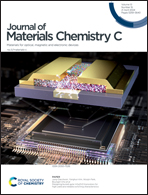Sb3+–doped 0D Cs3GdCl6 microcrystals with a near-unity photoluminescence quantum yield and high thermal quenching resistance for light-emitting application†
Abstract
All-inorganic lead-free luminescent metal halides doped with main-group ns2-electron ions have attracted considerable interest in a variety of optoelectronic applications. However, they normally suffer from severe thermal quenching of photoluminescence (PL) due to aggravated nonradiative relaxation at high temperatures. Herein, we report a new class of luminescent materials based on 5s2-electron Sb3+–doped 0D Cs3GdCl6 microcrystals (MCs), which exhibit intense yellowish PL at 540 nm under ultraviolet (UV) excitation, in parallel with a broad bandwidth of 510 meV, a large Stokes shift of 190 nm, a near-unity PL quantum yield, and remarkable resistance against thermal quenching (I150°C = 82.4%). Mechanistic investigation unravels that the broadband emission originates from the spin-orbital allowed 3P1 → 1S0 transition of Sb3+ which experiences a dynamic Jahn–Teller distortion in the excited state. These properties facilitate Cs3GdCl6:Sb3+ MCs as an efficient yellowish phosphor for near-UV-converted white light-emitting diodes, demonstrating a high color-rendering index of 96.4 and excellent operational stability. This work provides not only fundamental insights into the excited-state dynamics of Sb3+ in Cs3GdCl6 MCs, but also a new way for the exploration of novel and highly emissive rare-earth halides through ns2-electron ion doping towards various light-emitting applications.



 Please wait while we load your content...
Please wait while we load your content...